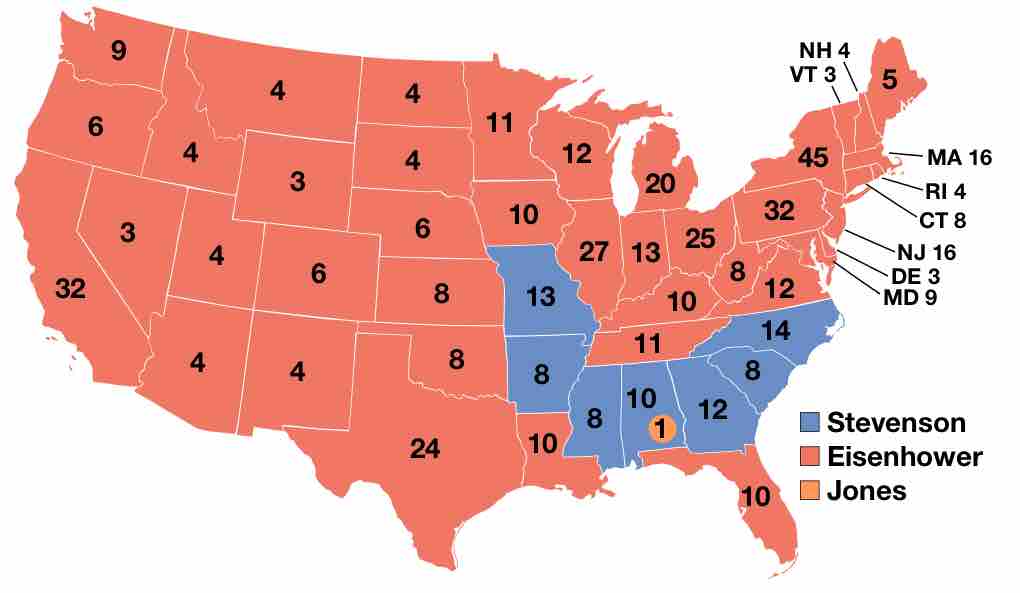INTRODUCTION
The United States presidential election of 1956 saw the popular incumbent President, Republican Dwight D. Eisenhower successfully run for reelection. The election was a rematch of 1952, as Eisenhower's opponent in 1956 was Democrat Adlai Stevenson, whom Eisenhower had defeated four years earlier. Eisenhower was popular but his health had become a quiet issue. Stevenson remained popular with a core of liberal Democrats but held no office and had no real base. Eisenhower had ended the Korean War, and the nation was prospering, so a landslide win for the charismatic Eisenhower was never in doubt.
NOMINATIONS
Early in 1956, there was some speculation that Eisenhower would not run for a second term, primarily due to concerns about his health. In 1955, Eisenhower had suffered a serious heart attack and in early 1956, he underwent surgery for ileitis. However, he quickly recovered and after being cleared by his doctors, he decided to run for a second term. Given Ike's (as the President was commonly known) enormous popularity, he was renominated with no opposition at the 1956 Republican National Convention in San Francisco, California.
The only question among Republicans was whether Vice President Richard Nixon would once again be on the ballot. Many speculated that Eisenhower privately offered Nixon another position in his cabinet, but in the spring of 1956, Eisenhower publicly announced that Nixon would be his running mate.
The highlight of the 1956 Democratic Convention came when Stevenson, in an effort to create excitement for the ticket, made the surprise announcement that the convention's delegates would choose his running mate. This set off a desperate scramble among several candidates to win the nomination. The two leading contenders were Senator Kefauver, who retained the support of his primary delegates, and young Senator John F. Kennedy of Massachusetts, who was relatively unknown at that point. Kennedy surprised the experts by surging into the lead on the second ballot; at one point he was only 15 votes shy of winning. However, a number of states then left their "favorite son" candidates and switched to Kefauver, giving him the victory. Kennedy then gave a gracious concession speech. The defeat was actually a boost for Kennedy's long-term presidential chances. By coming so close to defeating Kefauver, he gained much favorable national publicity. Yet by losing to Kefauver, he avoided any blame for Stevenson's expected loss to Eisenhower in November.
CAMPAIGN
Stevenson campaigned aggressively against Eisenhower, with television ads for the first time being the dominant medium for both sides. Because Eisenhower's 1952 election victory was due in large part to winning the female vote, there were a plethora of "housewife-focused" ads. Some commentators at the time also argued that television's new prominence was a major factor in Eisenhower's decision to run for a second term at age 66, considering his weak health after the heart attack in 1955. Television allowed Eisenhower to reach people across the country without enduring the strain of repeated coast-to-coast travel, making a national campaign more feasible.
Stevenson proposed significant increases in government spending for social programs and treaties with the Soviet Union to lower military spending and end nuclear testing on both sides. He also proposed to end the military draft and switch to an "all-volunteer" military. Eisenhower publicly opposed these ideas, even though in private he was working on a proposal to ban atmospheric nuclear testing.
Handling two developing foreign policy crises that occurred in the weeks before the election also helped Eisenhower. In the Soviet-occupied People's Republic of Hungary, many citizens had risen in revolt against Soviet domination, but this quieted with the formation of a new government. Then in Egypt, a combined force of Israeli, British, and French troops invaded to topple Gamal Abdel Nasser and seize the recently nationalized Suez Canal. Eisenhower condemned both actions but was able only to pressure the Western forces to withdraw from Egypt. The Eisenhower administration had also supported the Brown v. Board of Education ruling in 1954, which ended legal segregation in public schools.
RESULTS
On Election Day, Eisenhower took over 57% of the popular vote and won 41 of the 48 states. Stevenson won only six Southern states and the border state of Missouri, becoming the first losing candidate since 1900 (William Jennings Bryan vs. McKinley) to carry the Show-Me-State (Missouri would not vote for the losing candidate in a presidential election again until 2008). Eisenhower carried Louisiana, making him the first Republican presidential candidate to carry the state since Reconstruction in 1876. As a result of Eisenhower's support for the Brown v. Board of Education decision, he won the support of nearly 40% of black voters. He was the last Republican presidential candidate to receive such a level of support from black voters.

Electoral College Votes 1956
In this presidential election results map, red denotes states won by Eisenhower/Nixon, and blue denotes those won by Stevenson/Kefauver. Orange is the electoral vote for Walter Burgwyn Jones by an Alabama faithless elector. Numbers indicate the number of electoral votes allotted to each state.